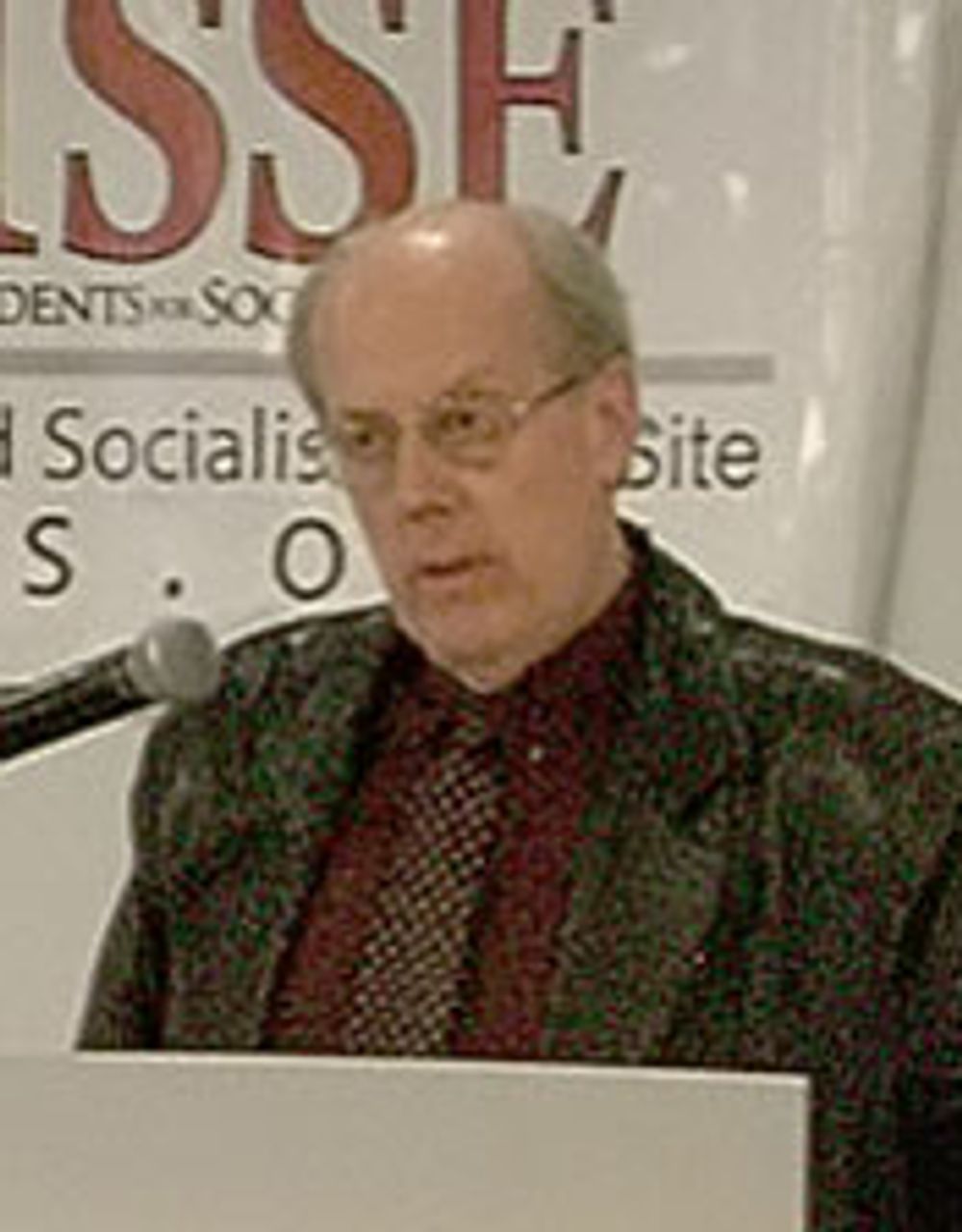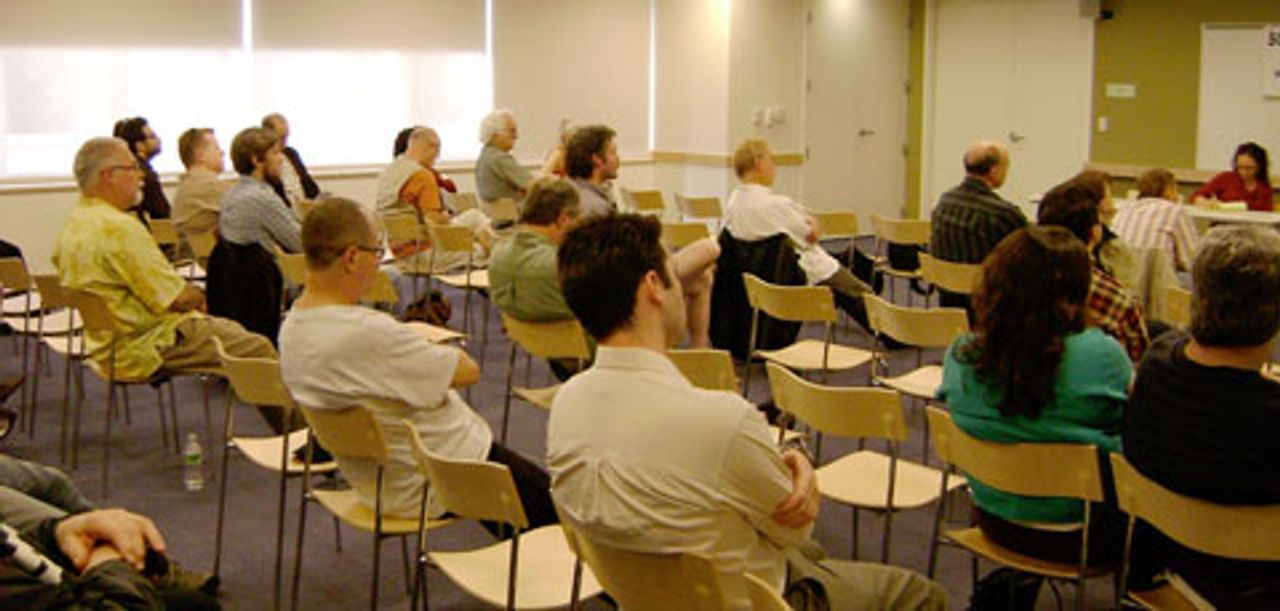David Walsh, arts editor of the World Socialist Web Site, spoke at San Diego State University and at the Santa Monica Public Library in the Los Angeles area February 26 and 28. The talks, entitled "The future of art in an age of crisis," drew significant audiences of students, artists, and workers and were followed by lively question and answer sessions, which raised a number of important issues.
Members of the local chapter of the College Republicans protested the event at San Diego State University. This protest, as tame and confused as it was, testifies in its own way to the growing presence of the International Students for Social Equality on university campuses and a renewed interest in socialism.
The talks began with a review of the ongoing financial crisis, touching on its international scope and depth and revolutionary implications. The speaker argued that Barack Obama's false promises would deepen popular dissatisfaction and prepare social explosions in the future. The majority of the remarks, however, concerned the cultural and artistic dimension of the crisis.
 David Walsh
David WalshAccording to David Walsh, artists have been largely caught unaware by the crisis. He noted that it would be difficult to mention even a single significant work of art in the recent past that evinced an awareness of what was to come. He asked: "Is there a body of work ... that in some fashion alerted the population to the smash-up that was coming?"
Obviously one could detect a general sense of foreboding and pessimism in several works and genres. Yet no clear and artistically compelling sense of the specific character of the crisis emerged from art in the period leading to it. There was no sense of how the wealth accumulated since the 1990s was fictitious and unsustainable. There was no inkling of the looming consequences of the mounting levels of social inequality, nor of the increasing inability of the existing political system to give voice to the most basic demands of working people.
Walsh remarked that what one can legitimately demand from art is not realism in a strict aesthetic sense, an obligatory focus on specific themes, or least of all a sense of allegiance to a specific political program. Rather, the inadequacy of contemporary art in the face of the crisis stems from its general inability to examine life seriously and with depth of feeling.
Walsh then turned to a historical review of the 20th century in order to explain the source of some of the artists' present difficulties.
Confronting looming crises of similar magnitude, artists in the past were able to examine, through the peculiar means available to their crafts, their nature and implications.
Walsh noted the presence of Marxism in the cultural life of American artists in the early part of the last century, including Dreiser, Fitzgerald, Hemingway, the figures of the Harlem Renaissance and others.
In particular, the epoch-making fact of the Russian Revolution had a profound effect on the consciousness of artists, opening up new vistas for them in terms of the potentiality of social life and political organization, to say nothing of artistic creation.
 A section of the audience in Santa Monica
A section of the audience in Santa MonicaWalsh was careful to point out that this was often not a process of direct political influence. It was not a certain level of programmatic agreement with Marxism that prepared artists to play a critical and useful social role in the crisis they faced. Rather, the presence of Marxist ideas and organizations contributed powerfully to the creation of a certain cultural climate and to the development of certain dispositions on the part of intellectuals and artists.
The degeneration of the Soviet Union with the emergence of Stalinism, in turn, took a serious toll at the level or art and culture. Walsh reviewed the manner in which the consolidation of Stalinism in the Soviet Union and internationally paved the way not just for political disasters, but also for the demoralization and disorientation of a whole layer of artists and intellectuals.
Walsh detailed the impact of the anti-communist purges in the postwar period and the role of American liberalism. Having served as apologists for the Stalinist crimes of the 1930s, scores of American liberals participated in the purges and anti-Communist witch-hunts of the 1940s and 1950s as well.
The intimidation of artists, as in the infamous case of the "Hollywood ten," and more broadly of intellectuals and workers in universities and in the trade unions, contributed to a multisided cultural and artistic impoverishment.
Following the decimation of genuine Marxism by Stalinism, as well as fascism, "The trends that remained standing, so to speak, and were widely considered ‘Marxist' ... had little in common with Bolshevism." In this context, Walsh referred to the role played by the Frankfurt School and Critical Theory. He briefly reviewed the grim conclusions about modern life drawn by Theodor Adorno and Max Horkheimer in Dialectic of Enlightenment (1944) and the deeply pessimistic outlook of Herbert Marcuse's One-Dimensional Man (1964). He noted, about the latter, that it was "an impressionistic and superficial response to the postwar boom and the political problems bound up with it."
Walsh went on, "The arguments of the Frankfurt School had and have implications for art. These were articulate figures, with a wide knowledge of culture and claiming a connection to Marxism, who wrote off the working class and the objective possibilities of social revolution." He went on to enumerate the implications for artists seeking to orient themselves and others in the postwar world.
Finally, Walsh commented on the development of post-structuralism and postmodern thought and their deplorable impact.
He discussed in particular Jean-François Lyotard, a French intellectual closely associated with postmodernism. Walsh noted Lyotard's rejection of "metanarratives," universalism, and the possibility of cognizing more or less accurately the objective world. Postmodernism enabled a strong turn toward identity and small-scale politics, as well as artistic dispositions toward cold, clever and unfeeling art.
Walsh's talk was followed by a lively and broad-ranging question and answer session both in San Diego and Los Angeles. The questions raised a number of issues, including the capacity of postmodernism to encourage critical art, the political significance of Ayn Rand, the fate of economics as an academic discipline, the intervention of the Socialist Equality Party in the recent Writers Guild of America strike, and the continuing availability of human drama and conflict for art in a socialist society.
A student in San Diego, for example, stated that it should be obvious that major artists, being in the pay of capitalism, would be complicit with the status quo. As an alternative, he proposed an orientation to independent and underground art.
In response, Walsh noted that the independence of art is not a purely economic matter determined by the manner in which a work is funded, or the social scale upon which the work is undertaken.
He explained that cinema, for example, is the quintessential modern art form in that historically it required a certain level of technology, a substantial social effort, and a mass audience. Cinema requires, in other words, a significant level of invested resources and of social participation. Contemporary "independent" cinema, even when disconnected from the circuits of capital accumulation, shows little actual independence of thought and orientation.
As Walsh noted, this is a question of perspective. In the 1930s and 1940s the studio system in Hollywood, although totally dependent on capitalist financing, was able to produce penetrating works that often were able to examine social reality in an honest and critical manner.
Contemporary underground art, in contrast, even when consciously "political" and opposed to existing conditions, continues to suffer from profound limitations. The impulse to rebel, mere disgust or anger with existing conditions is not enough, said Walsh. What is required is an accurate and sober understanding of the reality of the present situation, as well as of the history that led to it.
Several artists attended the meeting in Los Angeles. Some raised the objective difficulty of finding publishers or producers willing to invest in art that does not translate into profit.
Walsh noted that, although such obstacles doubtless exist in an industry dominated by six international conglomerates, in such contradictory and socially explosive times many artists will seek to develop a new perspective in order to wage their own struggle against the swindlers who run the industry. Those who, through their creative work, contribute directly to the production of art must ultimately have democratic control over the entertainment industry.
A painter also made an insightful comment about the work of the WSWS and its approach to cultural matters. What attracted him to the site was the serious attention that is given to questions of art and culture, including popular forms. According to the painter, the WSWS is the only organization that examines cultural issues not from a strictly political standpoint, but with the necessary depth and sensitivity.
